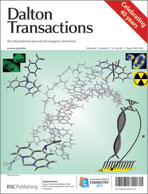Diphosphanes derived from phobane and phosphatrioxa-adamantane: similarities, differences and anomalies†
Abstract
The homodiphosphanes CgP–PCg (1) and PhobP–PPhob (2) and the heterodiphosphanes CgP–PPhob (3), CgP–PPh2 (4a), CgP–P(o-Tol)2 (4b), CgP–PCy2 (4c), CgP–PtBu2 (4d), PhobP–PPh2 (5a), PhobP–P(o-Tol)2 (5b), PhobP–PCy2 (5c), PhobP–PtBu2 (5d) where CgP = 6-phospha-2,4,8-trioxa-1,3,5,7-tetramethyladamant-9-yl and PhobP = 9-phosphabicyclo[3.3.1]nonan-9-yl have been prepared from CgP(BH3)Li or PhobP(BH3)Li and the appropriate halophosphine. The formation of 1 is remarkably diastereoselective, with the major isomer (97% of the product) assigned to rac-1. Restricted rotation about the P–P bond of the bulky meso-1 is detected by variable temperature ![[double bond, length as m-dash]](https://www.rsc.org/images/entities/char_e001.gif) CH(CO2Me)PR2 (6a–d) which have been used in situ to form chelate complexes of the type [MCl2(diphos)] (7a–d) where M = Pd or Pt. The PhobP-containing heterodiphosphanes 3 and 5a–d react anomalously with DMAD and do not give the products of diphosphination. The X-ray crystal structures of the
CH(CO2Me)PR2 (6a–d) which have been used in situ to form chelate complexes of the type [MCl2(diphos)] (7a–d) where M = Pd or Pt. The PhobP-containing heterodiphosphanes 3 and 5a–d react anomalously with DMAD and do not give the products of diphosphination. The X-ray crystal structures of the


 Please wait while we load your content...
Please wait while we load your content...